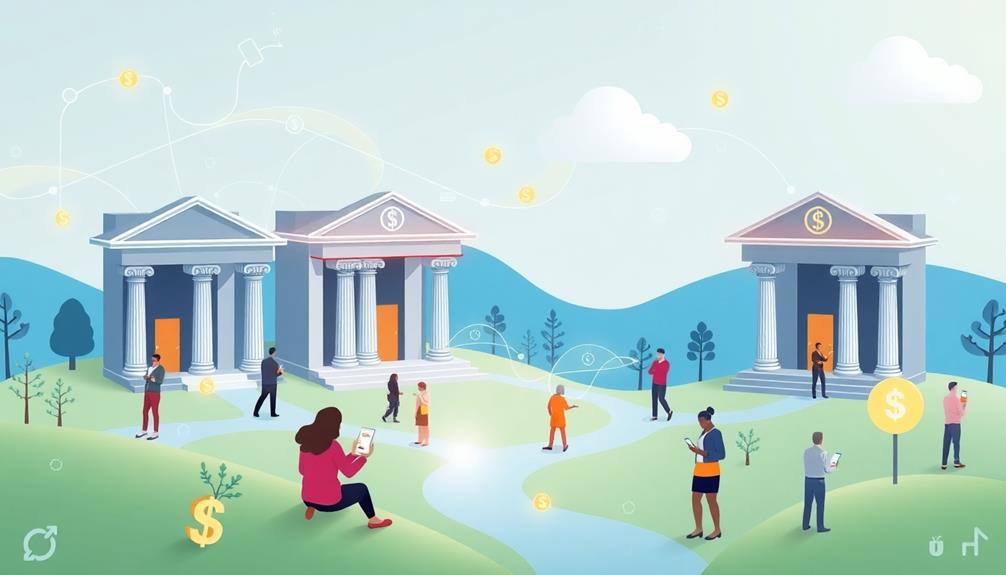Big Data plays an essential role in personalizing payment experiences by analyzing customer preferences and behaviors. With the immense data generated daily, you can enjoy tailored payment options that enhance convenience and security. By leveraging advanced analytics, businesses create targeted offers, driving engagement and satisfaction. This approach not only predicts your needs but also identifies opportunities for innovative solutions. However, to maintain your trust, companies prioritize data privacy and accuracy. By exploring this evolving landscape, you'll discover more about how these strategies reshape payment experiences for you and others.
Key Takeaways
- Big Data enables businesses to analyze customer behaviors, leading to tailored payment options that enhance satisfaction and loyalty.
- Advanced analytics from Big Data can uncover spending patterns, increasing customer engagement by up to 20%.
- Personalization strategies driven by Big Data include targeted marketing based on segmented customer profiles and transaction history for cross-selling opportunities.
- Transparency in data usage and robust security measures, such as encryption, are vital for building consumer trust in personalized payment solutions.
- Future trends like biometric authentication and contactless payments leverage Big Data to improve efficiency and user experience in payment processing.
Significance of Personalization in Payments

Personalizing payment experiences is essential for enhancing customer satisfaction and loyalty. When you understand customer preferences, you can tailor payment options that resonate with their needs. In fact, 50% of consumers prioritize quick, effortless loan payment solutions over interest rates, showcasing the demand for personalized experiences.
By leveraging Big Data, you can gain valuable insights into customer behaviors that inform your strategies. For example, analyzing customer data can reveal preferences for home security systems, allowing you to offer tailored payment options for services customers are already interested in.
Utilizing advanced analytics allows you to create segmented customer profiles, which leads to more effective targeted marketing campaigns. This approach not only improves conversion rates but also enhances the customer experience.
Personalized communication and reminders can greatly boost customer engagement and reduce delinquencies, ensuring that customers feel valued and understood.
Moreover, when you dynamically adjust payment options based on individual data, you're creating a more relevant and satisfying payment experience. By focusing on personalization, you open the door to cross-sell and upsell opportunities, ultimately driving revenue generation and fostering long-term customer retention.
Embrace the importance of personalization in payments, and watch as your customers become more loyal and engaged.
Understanding Big Data's Impact

Understanding the role of big data can greatly enhance how you approach payment experiences. With an estimated 2.5 quintillion bytes of data generated daily from online transactions and social media, you have a wealth of information at your fingertips. This data is essential for understanding customer behavior and tailoring payment methods to meet their needs.
By incorporating principles of trust-building activities into customer interactions, you can foster stronger relationships with your clientele, enhancing their overall experience.
By leveraging advanced analytics, you can uncover spending patterns and preferences that allow you to create personalized offers. This data-driven decision-making helps optimize your payment solutions, ensuring you provide the most relevant options for your customers.
Businesses utilizing big data in their payment strategies have seen a 20% increase in customer engagement and a 15% boost in the effectiveness of their personalized marketing campaigns.
Predictive analytics plays a key role in anticipating customer interactions, enabling you to enhance customer satisfaction. As the global big data analytics market grows, projected to hit $68.09 billion by 2025, you can't afford to ignore its potential.
Strategies for Effective Personalization

Harnessing big data analytics can transform how you personalize payment experiences for your customers. By leveraging data-driven insights, you can segment your customers based on behaviors and preferences, leading to more effective personalized marketing. Understanding customer demographics allows you to offer tailored payment options and reminders, fostering stronger relationships and enhancing satisfaction.
Additionally, adopting a growth mindset when analyzing data can help you identify new opportunities for customer engagement and innovation. Implementing predictive analytics enables you to anticipate customer needs, ensuring you deliver customized content and offers that resonate. This proactive approach not only boosts engagement but also drives conversion rates, allowing you to optimize your revenue generation strategies.
For instance, identifying cross-sell and upsell opportunities through transaction history can markedly improve overall profitability. Additionally, mobile-first payment solutions enhanced by big data provide a seamless user experience. Since 50% of consumers prioritize quick and effortless payment options over interest rates, catering to this preference can further elevate customer satisfaction.
Overcoming Challenges in Data Usage

When you're working with big data in payment experiences, data privacy concerns can't be ignored; 79% of consumers are uneasy about how their information's used.
As global awareness around social justice movements and data privacy grows, businesses must navigate these sensitivities carefully.
You also need to guarantee data accuracy, as poor-quality data can skew your personalization efforts.
Addressing these challenges is essential for building trust and driving effective decision-making.
Data Privacy Concerns
Data privacy concerns pose a significant challenge for financial institutions, with a staggering 79% of consumers uneasy about how their personal information is handled during payment processes. To tackle these issues, implementing robust data governance policies is vital, as 93% of organizations believe maintaining customer trust hinges on their ability to protect sensitive payment data. Compliance with regulations like GDPR and CCPA is essential to avoid hefty fines and reputational damage.
Here's a quick overview of key strategies for enhancing data privacy:
| Strategy | Description |
|---|---|
| Advanced Encryption | Secures data during transmission, reducing risks of breaches. |
| Biometric Authentication | Uses unique user traits for secure access, minimizing identity theft. |
| Transparency | Clear communication about data usage builds consumer confidence. |
| Compliance | Adhering to GDPR and CCPA fosters trust and avoids penalties. |
| Customer Trust | Prioritizing data privacy enhances customer loyalty and engagement. |
Ensuring Data Accuracy
Accurate payment data is essential for effective decision-making in today's fast-paced financial landscape. Inaccurate data can lead to misguided strategies, ultimately harming your customer engagement and retention.
To guarantee data accuracy and provide personalized experiences, consider these key strategies:
- Implement robust data governance policies to enhance reliability and guarantee compliance with industry regulations. Additionally, leveraging free SEO keywords acquisition can help in identifying relevant trends that may impact payment behavior.
- Utilize advanced analytics tools to identify and rectify inconsistencies in payment data.
- Employ automated data management solutions to conduct regular data cleaning and validation.
Future Trends in Payment Personalization

As you explore the future of payment personalization, you'll notice advancements in biometric authentication shaping security and convenience.
These innovations are akin to the focus on mindset to attract abundance in career, enabling users to feel more secure and empowered in their financial transactions.
With contactless payment options on the rise, you'll find that quick transactions are becoming the norm.
Plus, the expansion of subscription models will likely tailor payment experiences to fit your unique financial habits.
Biometric Authentication Advancements
Biometric authentication is revolutionizing payment experiences, making transactions not only more secure but also remarkably convenient. As you embrace these advancements, you'll find that biometric methods like fingerprint and facial recognition enhance user experience while addressing growing consumer demand for security.
With a projected market growth to $45.5 billion by 2025, it's clear that this technology is here to stay. Furthermore, the adoption of robust security measures in payment processing, especially as credit card fraud statistics indicate a significant rise in compromised records, further underscores the necessity of such innovations.
Consider these key benefits of biometric authentication:
- Secure Transactions: Enhanced encryption methods protect your biometric data, ensuring compliance with data privacy regulations.
- Convenience: Biometric authentication reduces transaction processing times by up to 50%, making your payments quicker and easier.
- User Preference: Studies show that 70% of users prefer biometrics over traditional passwords or PINs, highlighting a shift towards more intuitive payment solutions.
Contactless Payment Growth
The rise of biometric authentication sets the stage for another significant trend in payment experiences: the growth of contactless payments. With consumer demand for convenience and speed in transaction methods on the rise, contactless payments are projected to grow at a CAGR of over 19% from 2021 to 2026.
By 2023, around 50% of all in-store transactions in the U.S. are expected to be made using these methods, showcasing a clear shift in consumer preferences. This trend aligns with the crucial need for effective budget management as consumers seek to streamline their spending while maximizing convenience.
Mobile wallet usage is also driving this trend, with nearly 1.5 billion users anticipated globally by 2025, as consumers seek seamless payment experiences. The integration of biometric authentication enhances the security of contactless transactions, boosting consumer confidence.
As retailers adopt these solutions, they report a 30% reduction in checkout times, which not only improves customer satisfaction but also encourages repeat business.
Big Data analytics plays an essential role in understanding and adapting to evolving consumer preferences, helping businesses create personalized experiences around contactless payments. By leveraging this data, you can guarantee your payment solutions meet the needs of modern consumers, driving engagement and loyalty.
Subscription Model Expansion
Subscription models are revolutionizing payment personalization, offering consumers the convenience of automatic billing while allowing businesses to create tailored experiences.
With 60% of consumers open to personalized offerings, it's clear that adapting your subscription model can enhance customer satisfaction considerably. By leveraging big data analytics, you can analyze customer usage patterns and preferences, leading to improved retention rates.
Additionally, incorporating AI in Business practices can further refine these models by providing insights into customer behavior and preferences.
Consider these key strategies for optimizing your subscription model:
- Utilize AI and machine learning: Dynamically adjust pricing and offerings based on real-time data insights.
- Focus on personalized offerings: Tailor services to individual customer preferences, enhancing their payment experiences.
- Implement recurring revenue strategies: Capture steady income streams while meeting the evolving needs of your customers.
As the subscription-based payment model continues to grow at an impressive CAGR of 68% through 2027, integrating these strategies won't only help you stand out in a competitive market but also strengthen your relationship with customers.
Real-World Examples of Success

As companies increasingly embrace big data, numerous success stories highlight its transformative impact on payment experiences. By analyzing customer behavior and transaction data, businesses can create personalized experiences that boost customer satisfaction and engagement rates.
Here's a quick look at some real-world successes:
| Company | Success Story |
|---|---|
| Amazon | Utilizes big data for personalized product recommendations, increasing sales conversions by 29%. |
| Starbucks | Employs a data-driven loyalty program, with 40% of sales coming from loyalty members through personalized offers. |
| PayPal | Leverages big data analytics to reduce fraud by 50% and enhance payment experiences with personalized security measures. |
These examples showcase how understanding spending patterns and customer insights can lead to improved loyalty programs and customer satisfaction. Netflix also capitalizes on big data, achieving an impressive 80% engagement rate by tailoring content recommendations based on user behavior. Similarly, Mastercard uses transaction data to provide personalized spending insights, resulting in a 20% increase in customer satisfaction and loyalty. By adopting these strategies, companies not only enhance payment experiences but also drive significant business growth.
Frequently Asked Questions
How Does Payment Monitoring Use Big Data?
Payment monitoring uses big data to analyze transaction patterns and consumer behaviors. You'll identify anomalies, enhance fraud detection, and optimize processing times, ultimately improving your customer satisfaction and creating more targeted marketing efforts.
What Is the Role of Big Data in Financial Services?
Big data's role in financial services is essential. It helps you analyze customer behaviors, enhance engagement, optimize risk management, and improve fraud detection, ultimately driving better decision-making and personalized experiences tailored to your needs.
How Does Big Data Contribute to Personalised Marketing Strategies?
Big data's like a compass guiding your marketing strategies. It helps you understand consumer behavior, tailor messages, and predict needs, ensuring your campaigns resonate. With this insight, you'll foster deeper connections and drive engagement effectively.
What Are Some Benefits of Personalized Big Data?
Personalized big data boosts your experience by enhancing satisfaction, increasing engagement, and optimizing offers. You'll enjoy quicker payments, tailored communication, and more effective marketing, ultimately leading to greater loyalty and better financial health. Embrace the benefits!
Conclusion
In the evolving landscape of payments, big data acts like a compass, guiding you toward personalized experiences that resonate with your unique needs. As you navigate this digital sea, embracing tailored strategies can transform transactions into meaningful interactions. While challenges may loom like storm clouds, harnessing the power of data illuminates the path ahead. By staying attuned to future trends, you can guarantee your payment journey is not just efficient, but also a reflection of your individual journey.










